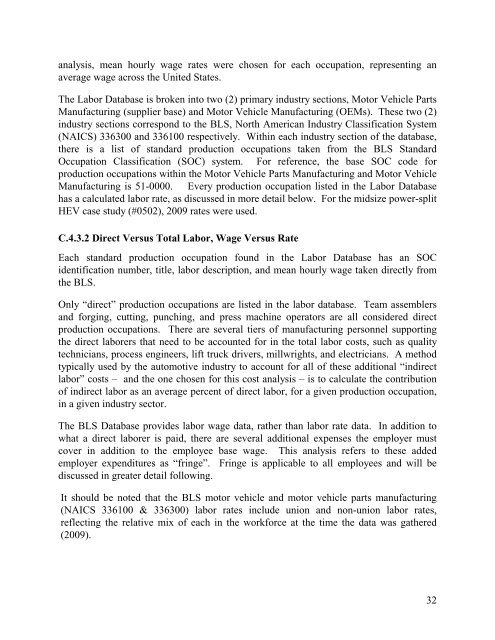Light Duty Technology Cost Analysis, Power - US Environmental ...
Light Duty Technology Cost Analysis, Power - US Environmental ...
Light Duty Technology Cost Analysis, Power - US Environmental ...
You also want an ePaper? Increase the reach of your titles
YUMPU automatically turns print PDFs into web optimized ePapers that Google loves.
analysis, mean hourly wage rates were chosen for each occupation, representing an<br />
average wage across the United States.<br />
The Labor Database is broken into two (2) primary industry sections, Motor Vehicle Parts<br />
Manufacturing (supplier base) and Motor Vehicle Manufacturing (OEMs). These two (2)<br />
industry sections correspond to the BLS, North American Industry Classification System<br />
(NAICS) 336300 and 336100 respectively. Within each industry section of the database,<br />
there is a list of standard production occupations taken from the BLS Standard<br />
Occupation Classification (SOC) system. For reference, the base SOC code for<br />
production occupations within the Motor Vehicle Parts Manufacturing and Motor Vehicle<br />
Manufacturing is 51-0000. Every production occupation listed in the Labor Database<br />
has a calculated labor rate, as discussed in more detail below. For the midsize power-split<br />
HEV case study (#0502), 2009 rates were used.<br />
C.4.3.2 Direct Versus Total Labor, Wage Versus Rate<br />
Each standard production occupation found in the Labor Database has an SOC<br />
identification number, title, labor description, and mean hourly wage taken directly from<br />
the BLS.<br />
Only “direct” production occupations are listed in the labor database. Team assemblers<br />
and forging, cutting, punching, and press machine operators are all considered direct<br />
production occupations. There are several tiers of manufacturing personnel supporting<br />
the direct laborers that need to be accounted for in the total labor costs, such as quality<br />
technicians, process engineers, lift truck drivers, millwrights, and electricians. A method<br />
typically used by the automotive industry to account for all of these additional “indirect<br />
labor” costs – and the one chosen for this cost analysis – is to calculate the contribution<br />
of indirect labor as an average percent of direct labor, for a given production occupation,<br />
in a given industry sector.<br />
The BLS Database provides labor wage data, rather than labor rate data. In addition to<br />
what a direct laborer is paid, there are several additional expenses the employer must<br />
cover in addition to the employee base wage. This analysis refers to these added<br />
employer expenditures as “fringe”. Fringe is applicable to all employees and will be<br />
discussed in greater detail following.<br />
It should be noted that the BLS motor vehicle and motor vehicle parts manufacturing<br />
(NAICS 336100 & 336300) labor rates include union and non-union labor rates,<br />
reflecting the relative mix of each in the workforce at the time the data was gathered<br />
(2009).<br />
32

















